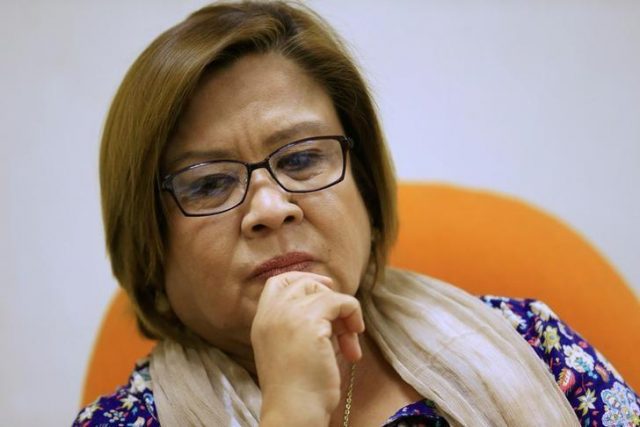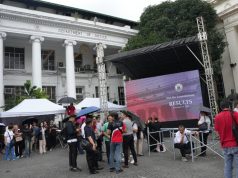(Atty. Sta. Maria is the resident legal analyst of TV5, co-host of the daily Radyo5 show “Relasyon” and dean of the Far Eastern University Institute of Law)
Why is the case of Senator Leila De Lima such an extraordinary case?
It is because, in a little over one year from the assumption of the Duterte administration, no less than the three great branches of government have converged to pin her down and, to some observers, bully or persecute her. This is unprecedented. We saw how the Executive department gathered the felons and the convicted drug lords to testify against her. Then we witnessed many in Congress totally besmirch her dignity using these convicted felons/drug lords.
Finally, the majority of the Supreme Court justices — Velasco, De Castro, Bersamin, Peralta, Tijam, Martirez, Segismundo, Del Castillo, Reyes — allowed her incarceration.
Significantly, Justices Velasco, De Castro, Bersamin, Peralta and Del Castillo were among the justices who previously voted in favor of the Marcos Burial and Martial Law espoused by President Duterte.
Justices Tijam, Martirez, Segismundo, and Reyes, on the other hand, are President Duterte’s new appointees.
Reading the dissenting opinions of Justices Carpio, Caguioa, Leonen, Sereno, Bernabe and Jardeleza, I shudder at how the majority of the justices can be so depthless. They preferred dealing with technicalities justifying the authority of the wrong court assuming jurisdiction over the case on the basis of a flawed information.
Justice Benjamin Caquioa’s stinging dissent said it all: “When the very rights guaranteed to an accused by our Constitution are disregarded and the rules of procedures are accorded precedence, that is abhorrent and preposterous. That is plain and simple injustice.” And this resulted in the most abominable situation of all: the wrong court, the Regional Trial Court, assuming jurisdiction, of a case which was within the sole and exclusive jurisdiction of the Sandiganbayan. The warrant of arrest against Secretary de Lima was therefore void. Chief Justice Maria Lourdes Sereno and also Justice Francis Jardeleza were of the same opinion.
Worse was what Justice Antonio Carpio pointed out. He severely criticized the majority, saying that in so doing, the Supreme Court countenanced a “fake charge” which was “blatantly a pure invention.” He further said that it is “one of the grossest injustices ever perpetuated in recent memory in full view of the Filipino nation and the entire world.” Another dissenter, Justice Estela Perlas-Bernabe, said simply but decisively that the charges were “a sham.”
Justice Leonen described the decision of the majority as “disturbing” because “it unsettles established doctrine, misapplies unrelated canons, and most importantly fails to render a good judgment: law deployed with sound reasons taking the full context of the case as presented.”
Courage in SC during Marcos dictatorship
I cannot help but compare the kind of Supreme Court we have now with the Supreme Court during the latter days of the Marcos dictatorship. Though appointed by the dictator Marcos, a number of the then SC justices had the courage and the brilliance not to go with the tide of brute power and influence of the executive. When the late former senator Jovito Salonga was framed by the government as having conspired in the bombing activities of certain disgruntled people violently against Martial Law, witnesses were presented against Senator Salonga. They included an ambassador, a consul general, the Presidential Security Command chief and also the alleged bomber. The judge denied motions of Salonga’s lawyers for the dismissal of the trumped-up charges against him. Former Senator Jovito Salonga went to the Supreme Court.
In Salonga vs. Paño et al (G.R. No. 59524 February 18, 1985), the Supreme Court, through then Associate Justice Hugo Gutierrez, castigated the government for incriminating Senator Salonga, for gross violation of his constitutional rights, and for indicting him on the basis of evidence not credible both as to source and of themselves. Sensing that the case was about to be decided negatively against it, the Executive department ordered the release of Senator Salonga to render the Supreme Court case moot and academic.
However, while the Supreme Court indeed ruled that the case became moot and academic, it nevertheless pounded on the total injustice of the whole case against Senator Salonga. It extraordinarily released the full decision with a complete explanation of governmental abuse of power. The Supreme Court said: “It bears repeating that the judiciary lives up to its mission by vitalizing and not denigrating constitutional rights. So it has been before. It should continue to be so.” Except for three justices who did not take part, all the magistrates then led by the ponente Associate Justice Hugo Gutierrez, signed the decision. Can we say the same today of at least majority members of the present Supreme Court?
Now, what are we witnessing: three great branches of government: the EXECUTIVE, the LEGISLATIVE, and the JUDICIARY against one woman. Nothing is more extraordinary. It takes a person of great fortitude to withstand the onslaught of such institutional bombardment and to continue to fight for reason and justice against all odds.










